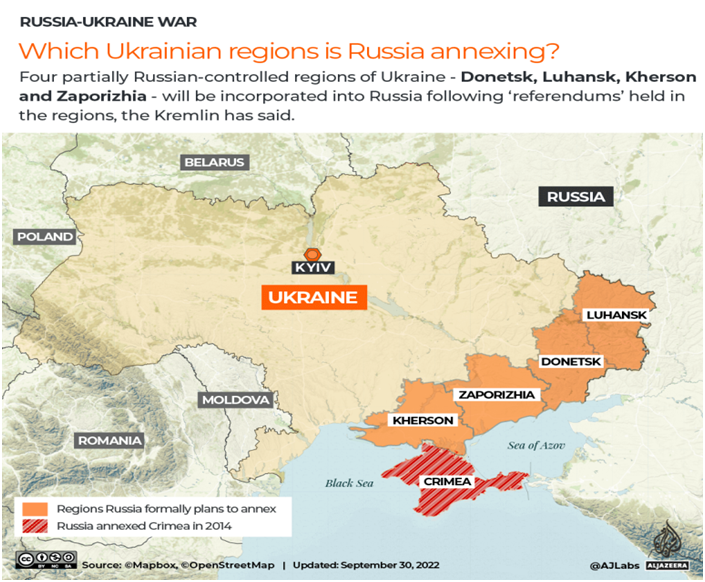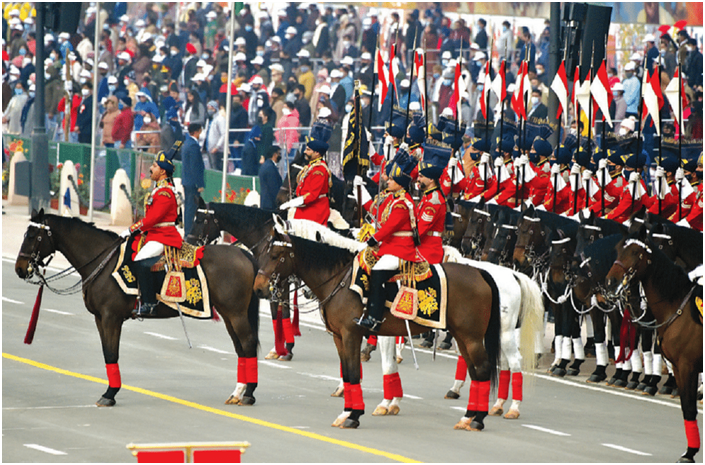Russia annexes four Ukrainian regions (GS Paper 2, International Relation)

Why in news?
- Recently, the Russian President Vladimir Putin signed an accord to formally annex four Ukrainian regions to Russia.
- He said that the people living in the four regions are “Russian citizens forever” and any attack on the annexed regions will be an “attack on Russia.”
Key Highlights:
- He announced the annexation of Lugansk, Donetsk, Kherson and Zaporizhzhia.
- With the formal announcement of the four regions;Russia is now in control of 15 per cent of Ukraine’s territory.
What it means for Russia?
- In addition to occupying more land, Russia now have a larger pool of people to draft into the military. With these regions joining Russia, they are eligible to be drafted to fight for Russia against Ukraine.
- There are also tactical benefits to annexing Ukrainian territory. After failing to achieve his ambitions of taking over Kyiv and removing the government led by President VolodymyrZelenskyy, Russia’smove of annexation will help him shore up his power and cement his control over regions.
- But by annexing Ukrainian territory, Russia has given a further justification for the mobilisation.
- Russia may also hope that the move will boost support for the war both domestically and among Russia’s international allies, such as China.
Background:
- The separatist Donetsk and Luhansk regions in eastern Ukraine have been backed by Moscow since declaring independence in 2014, weeks after the annexation of Ukraine’s Crimean Peninsula.
- The southern Kherson region and part of the neighboring Zaporizhzhiawere taken by Russia soon after Putin sent troops into Ukraine on 24 February.
Presidents Bodyguards regiment completes 250 years
(GS Paper 3, Defence)
Why in news?
- Recently, the President’s Bodyguards (PBG) carried out training at Malpura drop zone in Agra as the regiment completed 250 years.
- A detachment of the President’s Bodyguard regiment remains permanently deployed at Siachen Glacier, the world’s highest battlefield.

About President’s Bodyguard:
- President’s Bodyguard is the senior-most Regiment of Indian Army.
- The President’s Bodyguard, raised by Governor-General Warren Hastings in September 1773, is the senior most regiment in the order of precedence of the units of the Indian Army and it is a regiment carrying out ceremonial duties for the President of India.
- The personnel are excellent equestrians, capable tank men and paratroopers.
- It is equipped as a mounted unit, with horses for ceremonies at the presidential palace and BTR-80 vehicles for use in combat.
- The personnel of the regiment are also trained as paratroopers and nominally are expected to lead in airborne assaults in the role of pathfinders. The regiment is the successor of the Governor General’s Bodyguard of the British Raj.
Action:
- The regiment saw action in Operation Ablaze in 1965 in the western theatre, with the Indian Peace Keeping Force in Sri Lanka in 1988-1989 and with the Indian United Nations Contingents in Somalia, Angola and Sierra Leone.
- After Independence, the President’s Bodyguards have seen action in several areas. In 1962, its armoured cars were deployed for the defence of Ladakh’sChushul at heights of over 14,000 feet.
Fact:
- The Bodyguard was the only corps of cavalry in the Bengal Presidency until 1777 when two regiments of cavalry were transferred to the Company by the Nawab of Oudh. Both the regiments were raised in 1776.
AFSPA extended in three districts of Arunachal Pradesh for six months
(GS Paper 3, Internal Security)
Why in news?
- Recently, the Central government has extended the Armed Forces (Special Powers) Act in three districts of Arunachal Pradesh.

Details:
- The Ministry of Home AffairsdeclaredTirap, Changlang and Longding districts as ‘disturbed area’ under Section 3 of the Armed Forces (Special Powers) Act, 1958 for a period of six months with effect from 1 October 2022 to 30 March 2023.
- In addition, the Government of India has also extended AFSPA in the areas falling within the jurisdiction of Namsai and Mahadevpur police stations in Arunachal Pradesh.
Background:
- Earlier in 2022, the Central had declared Tirap, Changlang and Longding districts in Arunachal Pradesh and the areas falling within the jurisdiction of Namsai and Mahadevpur police stations in Namsai district of Arunachal Pradesh, bordering the State of Assam, as ‘disturbed area’ for six months from 1 April to 30 September 2022.
What is AFSPA?
- The British colonial government had on 15th August, 1942, promulgated the Armed Forces Special Powers Ordinance to suppress the Quit India movement.
- It was the foundation for four ordinances, including one for the “Assam disturbed areas” invoked in 1947 to deal with Partition-induced internal security challenges.
- The Armed Forces (Special Powers) Bill was passed by both the Houses of Parliament and it was approved by the President on September 11, 1958. It became known as the Armed Forces Special Powers Act (AFSPA), 1958.
- The AFSPA empowers security forces to arrest a person without a warrant and enter or search premises without a warrant along with some other actions.
What is a disturbed area?
- A disturbed area is one that is declared by notification under Section 3 of the AFSPA. It can be invoked in places where the use of armed forces in aid of civil power is necessary.
- The Act was amended in 1972 and the powers to declare an area as “disturbed” were conferred concurrently upon the Central government along with the States.
- The Central Government, or the Governor of the State or administrator of the Union Territory can declare the whole or part of the State or Union Territory as a disturbed area.
India abstains from UN resolution against Russian annexation of Ukrainian regions
(GS Paper 2, International Relation)
Why in news?
- Recently, India abstained on a draft resolution tabled in the UN Security Council which condemned Russia’s referenda and annexation of four Ukrainian territories and called for an immediate cessation of violence while underlining the need to find pathways for a return to the negotiating table.

What was the resolution?
- The UN Security Council voted on the draft resolution tabled by the United States and Albania that condemns Russia’s organisation of referenda in regions within Ukraine’s internationally recognised borders.
- The resolution declares that Russia’s “unlawful actions” with regards to the “illegal so-called referenda” in parts of Ukraine’s regions that are under Russia’s temporary control can have “no validity” and cannot form the basis for any alteration of the status of these regions of Ukraine, including any purported annexation of any of these regions by Moscow.
- It also decides that Russia shall immediately, completely, and unconditionally withdraw all of its military forces from the territory of Ukraine within its internationally recognised borders, which includes those regions addressed by the “illegal so-called referenda” to enable a peaceful resolution of the conflict between Russia and Ukraine through political dialogue, negotiation, mediation or other peaceful means.
Abstaining nations:
- The resolution failed to get adopted as Russia vetoed it. Of the 15-nation Council, 10 nations voted for the resolution while China, Gabon, India, and Brazil abstained.
India’s stand:
- Referring to PM Modi’s remark to Putin on the sidelines of the Shanghai Cooperation Organisation (SCO) Summit in Uzbekistan’s Samarkand that today’s era is not an era of war, India’s Permanent Representative to the UN said that India sincerely hopes for an early resumption of peace talks to bring about an immediate ceasefire and resolution of the conflict.
- India’s position has been clear and consistent from the very beginning of this conflict. The global order is anchored on the principles of the UN Charter, international law and respect for sovereignty and the territorial integrity of all states. Escalation of rhetoric or tension is in no one’s interest.





